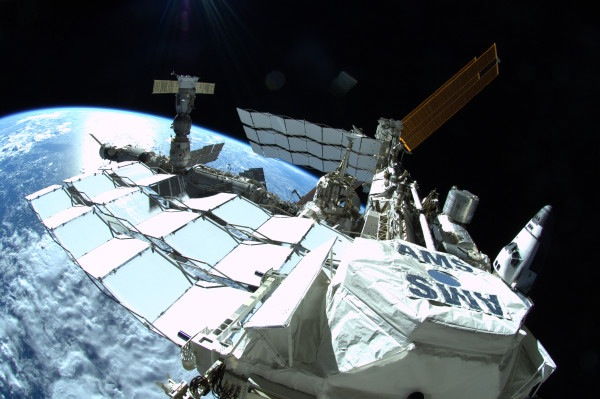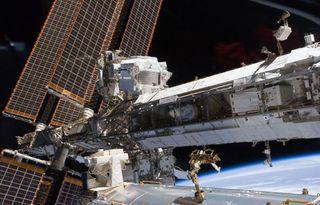Hints of Dark Matter Have NASA Scientists Over the Moon

WASHINGTON — Patience and meticulous science were cause for celebration when an international team of scientists announced new results pointing to the possible detection of dark matter Wednesday (April 3).
Although the James E. Webb Auditorium was nearly empty here at NASA Headquarters, it did not stop space agency officials and scientists from enthusiastically unveiling new findings in a news conference Wednesday.
A somewhat anxious, yet excited tone took over the room as people trickled in right before the briefing began.

"Congratulations," one NASA colleague said to Michael Salamon, the U.S. Department of Energy Office of Science program manager for the Alpha Magnetic Spectrometer (AMS).
"There have been little glitches, but the end product is here for all of us to see and it's a happy day," Salamon said during the briefing. [Dark Matter Across the Universe (Gallery)]
NASA officials are excited because a team of scientists may have just found strong evidence supporting the existence of elusive dark matter thanks to a bus-size particle detector (the AMS) mounted on the outside of the International Space Station.
By sifting through a year-and-a-half of data, scientists have found about 400,000 positrons — the antimatter partner particles of electrons — that are at the right energy to suggest they were created when particles of dark matter collided and annihilated each other.
Get the Space.com Newsletter
Breaking space news, the latest updates on rocket launches, skywatching events and more!
"Some days, my job is really great, and this is one of those days where my job is really great," William Gerstenmaier, the NASA associate administrator for Human Exploration and Operations, said.
Although the results might be exciting, the $2 billion detector that collected them almost never made it to space.
NASA canceled the AMS program due to concerns for astronaut safety in 2005, two years after the Columbia space shuttle accident. The cancellation caused backlash in the scientific community, leading Congress to approve funding for an extra shuttle mission to bring the instrument to the orbiting outpost.
"I guess it teaches us that patience is an important quality to have," Gerstenmaier said. "There were times where we were uncertain about exactly what the future was going to be, we knew the quality of science was pretty strong and was pretty important and the team hung in there … and kept kind of pursuing their passion, their dreams in pretty uncertain and turbulent circumstances, but they kept moving forward, all the teams and eventually things worked out."
The AMS was launched to the International Space Station in May 2011, and has been sending back data since its installation. The particle physics experiment is led by Nobel laureate Samuel Ting, a physics professor at MIT, with 200 scientists from 56 different institutions in 16 countries participating on the science team.
Wednesday's results represent the first chunk of data published by the international team of scientists working with the instrument.
"I think it's just kind of the beginning of other great things that will come from this instrument on board space station," Gerstenmaier said.
Follow Miriam Kramer @mirikramer and Google+. Follow us @Spacedotcom, Facebook and Google+. Original article on SPACE.com.
Join our Space Forums to keep talking space on the latest missions, night sky and more! And if you have a news tip, correction or comment, let us know at: community@space.com.

Miriam Kramer joined Space.com as a Staff Writer in December 2012. Since then, she has floated in weightlessness on a zero-gravity flight, felt the pull of 4-Gs in a trainer aircraft and watched rockets soar into space from Florida and Virginia. She also served as Space.com's lead space entertainment reporter, and enjoys all aspects of space news, astronomy and commercial spaceflight. Miriam has also presented space stories during live interviews with Fox News and other TV and radio outlets. She originally hails from Knoxville, Tennessee where she and her family would take trips to dark spots on the outskirts of town to watch meteor showers every year. She loves to travel and one day hopes to see the northern lights in person. Miriam is currently a space reporter with Axios, writing the Axios Space newsletter. You can follow Miriam on Twitter.










